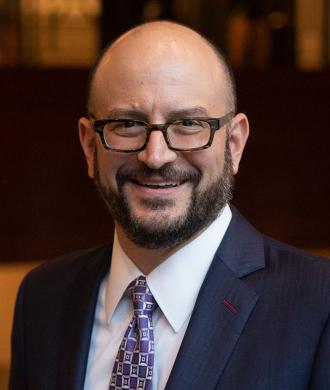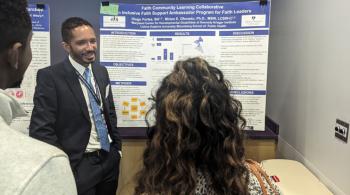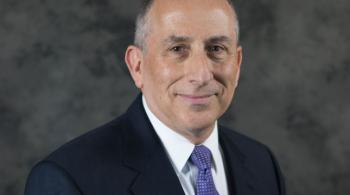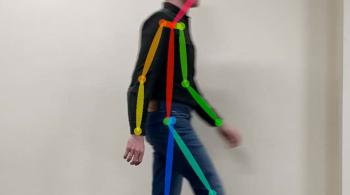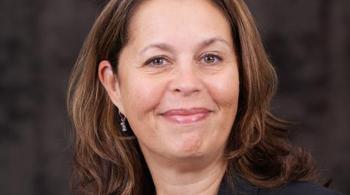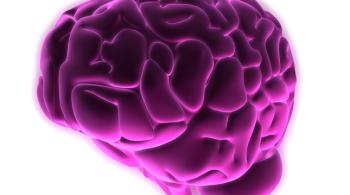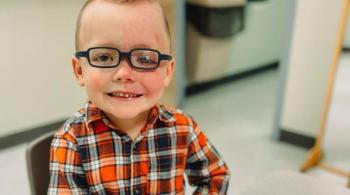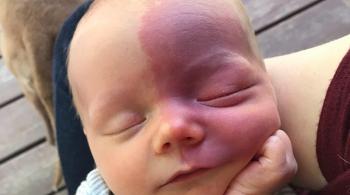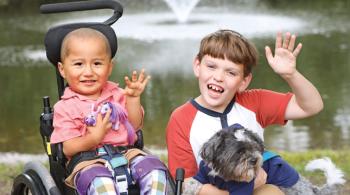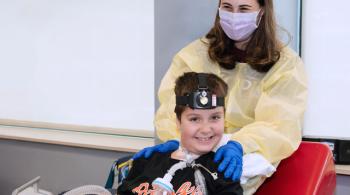April is known internationally as Autism Acceptance Month. As part of that recognition, join Dr. Brad Schlaggar, president and CEO of Kennedy Krieger and his guests Drs. Amy Keefer and Roma Vasa from the Center for Autism, Services, Science and Innovation, to discuss the anxiety disorders common in individuals with autism and discuss why this population may be particularly vulnerable to the comorbid symptoms of anxiety, as well as treatment options and research being done in this field.
Learn More About Kennedy Krieger Faculty & Staff Members Featured in This Episode
Learn More About Kennedy Krieger Faculty & Staff Members Featured in This Episode
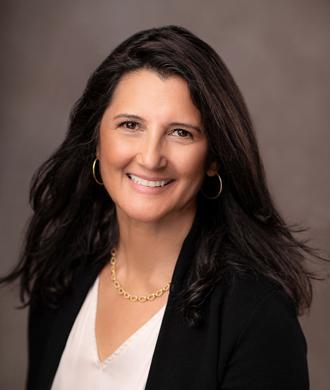
Roma
Vasa
,
MD
View Episode Transcription
Dr. Brad Schlaggar (BS): Welcome to Your Child's Brain, a podcast series produced by Kennedy Krieger Institute with assistance from WYPR. I'm Dr. Brad Schlaggar, pediatric neurologist and President and CEO of Kennedy Krieger Institute. Anxiety disorders are the most common disorders of mental health in the United States, affecting about 18% of the general population. Research has shown that the incidence of anxiety in people with autism may be significantly higher than in the general population. One systematic review of the published research on anxiety and autism found that almost 40% of children with autism and 50% of adults with autism experienced some anxiety disorder. Phobias are the most common form of anxiety disorder among people with autism. A person with a phobia can experience distress, including extreme distress when exposed to a specific stimulus or situation that triggers that phobia or fear. Obsessive compulsive disorder and social anxiety disorder are also frequently occurring. April is known internationally as Autism Acceptance Month. Now originally, and this goes back over 50 years, it was Autism Awareness Month. As part of that recognition, in this month's episode of the podcast, we're going to unpack the anxiety disorders common in individuals with autism, and discuss why people with autism may be at greater risk for having anxiety. We'll also talk about treatment options and research being done in this very important field. I'm joined today by two of my exceptional colleagues at Kennedy Krieger Institute Drs. Amy Keefer and Roma Vasa. Doctor Amy Keefer, a pediatric psychologist at Kennedy Krieger's Center for Autism Services, Science and Innovation, is board certified in cognitive and behavioral psychology and she is an assistant professor in the Department of Psychiatry and Behavioral Sciences at the Johns Hopkins University School of Medicine. Doctor Roma Vasa, a child and adolescent psychiatrist, is the director of Psychiatric Services at the Center for Autism Services, Science and Innovation. She's a professor of Psychiatry in the Department of Psychiatry and Behavioral Sciences at the Johns Hopkins University School of Medicine. It's also my pleasure to welcome Miss Amola Surya. Miss Surya is the mother of Ronick, who has both autism and anxiety, so welcome everyone. Before we get started, I'd like to acknowledge that in the autism advocacy community, there are varying perspectives on language. Some prefer the use of person first language, for example, Johnny is a person with autism, and others prefer the use of identity, first language, for example, Sally is an autistic person. At Kennedy Krieger, we recognize and respect these perspectives. We think that the most inclusive approach is to respect the range of perspectives, use the language interchangeably and whenever possible, ask an individual how they would like to be identified. Roma, let's start with some clinical definitions, what is autism and what's anxiety?
Dr. Roma Vasa (RV): Let's start with autism. Autism is a neurodevelopmental condition. It's characterized by difficulty in two areas, social communication and restricted repetitive behaviors and interests. Autism is considered neurodevelopmental because many features show up early in development, although in some people the diagnosis is made later. In contrast, anxiety is considered a psychiatric disorder that can show up at any time in life, when you're young, school age, or as an adult. The hallmark of anxiety is excessive fear or worry about different types of situations and anxiety is associated with changes in behavior and thinking. One is neurodevelopmental, shows up early, and the other is more psychiatric, and can show up throughout the lifespan.
BS: Great, let's break down anxiety disorders a bit more. There are multiple types of anxiety disorders that we group together under this general category. Can you give us a brief overview and then let's discuss how having these diagnoses, both autism and anxiety can impact both children and adults in their daily lives.
RV: Sure, so there are many different types of anxiety disorders and these are named based on the content of what children are scared of or worry about. Like you said earlier at the beginning, phobias are the most common, it's when you have excessive distress and fear about a certain situation or object. Obsessive compulsive disorder, which is characterized by intrusive thoughts and compulsive rituals, social anxiety, the hallmark of which is when you talk to people, you feel nervous that you're going to be judged or laughed at. Separation anxiety is when you're worried that something bad is going to happen to someone you love and the last is general anxiety. When somebody is worried about all things in daily life, like making mistakes and failing and not being good enough, the weather, death and dying. Regardless of the type of anxiety getting to the second part of your question, all of these types of anxiety are considered disorders when they're excessive and when they interfere with functioning. Anxiety can impact a child's daily life because it can interfere with their performance at school, their interactions with peers, and their ability to participate in therapies. It can also impact family functioning because sometimes parents want to do everything possible to reduce their child's distress, so they change their schedules, they might have to take time off of work, their sleep is disrupted. Even siblings are affected because they might receive less attention from their parents or they can't do the activities that they want to pursue. The child's anxiety impacts the child, but also many others in the family.
BS: Amy, you and Roma in your work over years, and others too, I think mostly you guys, have found that autistic children higher rates of anxiety than children without autism. What prevalence rates are we talking about? Why do you think that the rates are significantly higher for anxiety in autism?
Dr. Amy Keefer (AK): Well, current research indicates that 30% of autistic children who are under the age of six years and about 40% of seven to 18 year old autistic children experience clinical levels of anxiety. These prevalent rates are two to three times higher than the rates of anxiety that we see in children in the general population. In some autistic children, the risk for anxiety increases as they get older and may be particularly high as they enter adolescence. However, for many autistic children, anxiety begins when they're very young, so under the age of six years, and continues to impact them across the lifespan. Unfortunately, we do not know why anxiety is so prevalent in autistic children, one hypothesis is that anxiety and autism may share some common genes and brain pathways. Another is that anxiety arises as a result of the stress that autistic people experience living in a world that's designed more for neurotypical people. But at this point, just more research is needed to really understand the connection.
BS: Just I want to underscore that over the course of development, the prevalence ranges change for anxiety in the setting of autism. Why do you think that might be playing out? What do you think the developmental course, what the implications are for why that might be the case?
AK: Yes, again, I think a lot of people wonder if stress and other challenges that the individual experiences, particularly if they are in environments where maybe they're not receiving sufficient resources and supports might play into that and really increase the risk of anxiety as they age.
BS: Roma, we know that a common feature of both autism and anxiety is that they can impact social interactions. For example, autistic individuals have difficulty with different aspects of social communication. Anxiety can show up as social anxiety as we're talking about. What are the similarities and differences in how autism and anxiety impact social functioning?
RV: Both of these conditions can affect the way an individual interacts with others. The common features, whether you have autism or whether you have social anxiety, in both, there's a tendency to want to avoid talking to people. Maybe running away, and young children will hide. They might not show interest in others, they might look frozen, their eye contact might be diminished, and they might not look directly at you. There's just a general, I don't want to interact kind of feeling. The differences between the two though, are the reasons why that behavior is occurring. In autism, the social difficulty, the reason to not want to interact is because you might be less interested. That might not be your favorite thing to do, or you might have difficulty understanding social cues or knowing how to identify and express your feelings. Because that's hard, you'd rather not interact. That's your preference. In social anxiety, the reason for not wanting to interact is less so about the social understanding. Usually people with social anxiety do have social understanding. They do have social motivation, but what they are worried about is being judged or laughed at. Very different reasons. I want to emphasize that a person with autism can have both autism plus social anxiety. What the social anxiety does is it increases the autism symptoms. If you're generally someone who doesn't prefer eye contact and doesn't like eye contact, that's going to be even more heightened, if you're anxious.
BS: Picking up on that point, Amy, beyond social anxiety, what other types of anxiety do autistic individuals experience. Then to the point that Roma was just making, if anxiety and autism travel together and they interact so that autism influences the way anxiety manifests in individuals with autism how do you think about discerning the kinds of anxiety that you're seeing? What types of anxiety do we see in individuals with autism? If there's an interaction, how do you discern that type of anxiety in the setting of autism?
AK: Well, as we said previously, we know autistic individuals can experience all the same types of anxiety that are experienced by non-autistic individuals. That same list of anxiety disorders that Roma went through at the beginning of our talk. But we do know that in some individuals that anxiety can look and present a little bit differently. There's more distinct types of anxiety that we see sometimes experienced by autistic individuals. For example, some autistic children experience anxiety and distress in social situations. But as Roma mentioned earlier, unlike others who might have that worry about what others might think about them or how they're being judged or that they might be embarrassed that those worries are gone. It's just discomfort and not feeling okay in social situations. Roma also mentions specific phobias, so in autism, certainly again, individuals can have phobias, but they might look a little bit different. Children may have fears about some sensory component that they might encounter in the real world and the potential of a negative sensory experience. For example, some children might develop a fear of entering public restrooms because of the potential that they might encounter a loud flushing toilet or the loud automatic hand dryers. OCD can also look different in autism. In this situation, the child might have the rituals and the repetitive behaviors that have a compulsive quality or an anxious quality that we typically see in OCD. But they may not have those same obsessive thoughts to accompany it that we might see outside of autism. Really, we think about these things as the anxiety being influenced by the presence of the autism and you're right, teasing those things apart can be really tricky.
BS: Before we go further discussing the clinical research, I'd like to bring Amola into this discussion. Amola welcome and could you tell us about your son Ronak, when and how he was diagnosed with autism?
Amola Surya (AS): Yes. My son Ronak is seven years old and now in second grade, but he was diagnosed when he was two-and-a-half years old. Since then has participated in many different therapies and of course, in school as well and progressed in his skills or gone through some other experiences as well. He actually has experienced many different anxieties since he was younger, so a lot of social anxiety. Other outside influences such as fireworks, dogs, thunderstorms, you name it. We were at a point where we didn't know how to handle it or help him and he was not able to self regulate. That's where we were looking for help and different treatments.
BS: When did you first become aware that there was an anxiety component to what Ronak was experiencing?
AS: I first realized that there was an anxiety component when it was difficult to do anything from distracting him or getting him to not focus on the issue that was giving him anxiety. For example, whenever we would leave the house and it was stormy and lightning and thundering, he would have such a visceral reaction with screaming or covering his ears, not wanting to even look outside the window, just things that were stopping him from his every day norms. I just felt like that was also affecting the whole family in our daily routine.
BS: Has he required treatment for his anxiety? If so, has there been benefit from the treatment?
AS: Yes. We had actually turned to Amy and her team, and they helped us very much with handling his anxiety and of course, directly with Ronak, but also directly with me as a parent on how to help him. Through the guidance, we were able to really step back. Instead of being reassuring or avoiding the whole situation that was giving him anxiety or pressuring him or forcing him too much to face the anxiety, we were given a lot of tips and tools on how to break down the different steps to help Ronak gain the confidence to self regulate or face his anxiety without pushing him too far and just creating and giving that balance.
BS: What would you at this point like to tell other parents who are perhaps just starting this journey with their child?
AS: Don't give up, it will get better. There's always someone who's gone through it who can help you not to avoid it, but at the same time to break it down in small steps. It's just more attainable for your child and also just to keep calm yourself. An escalated parent cannot deescalate the child. That was number one for me and has been so helpful even now.
BS: Can you share with us how you think about your hope for Ronak's future? How do you think about what's coming next for him?
AS: Absolutely. He has come so far and even though he's just seven, I have these great hopes of him even gaining more skills and just becoming as independent as he can be and more confident in his skills just as he grows.
BS: That's wonderful. I appreciate you sharing that with us, and I think it's a great set up for talking about the clinical research that Roma and Amy have been carrying out. Let's dive into that a bit. Amy, one treatment approach for anxiety is cognitive behavioral therapy. Can you tell us about behavioral therapy, what it is and how it works?
AK: CBT for anxiety is a treatment that was first developed for non-autistic adults and children with anxiety. It's been shown to work very well in non-autistic children, with about 60% of them having a reduction in anxiety after completing CBT. In general, CBT involves teaching individuals about their anxiety symptoms and different strategies to manage them. A primary component is the completion of homework outside of therapy sessions to help generalize the skills that you practice in the therapy. When CBT is delivered to children, parents are usually involved to help reinforce concepts and to really structure the child's practice of the new skills. That's really important if it's going to really be meaningful and make a difference in their life. Now, over the past 10 years, researchers have developed a new version of CBT that's specifically for autistic children. This has been developed for autistic children who do not have cognitive delays. Some people call it modified or adapted CBT. The evidence shows that modified CBT is effective in reducing anxiety in this group of children, particularly if they're in the 8-14 year old range and have fluent language skills. But currently, there are several investigators who are looking at the efficacy of new CBT models for anxiety in autistic children in other age groups, like younger children and also children with cognitive and language delays. What modifications would have to be made to what would have been a standard CBT approach to take into account that the person has autism? There can be a lot of discussion in CBT about thoughts and a lot of requirements that people spend a lot of time thinking about their thinking, which is a pretty abstract, we sometimes call it like a meta-cognitive process that's hard for kids to do in general, and it can be hard for some autistic people. We tend to substitute that more with more behavioral action based strategies that they can use to help regulate. We also tend to use a lot of visuals and look for ways that can really be reinforcing to the children to help them feel motivated to try the new strategies.
BS: Roma, you've studied this phenomenon called intolerance of uncertainty. Intolerance of uncertainty appears to be an important factor driving anxiety in the setting of autism. Can you define for us what that means and how it relates to this intersection of autism and anxiety?
RV: Intolerance of uncertainty is when somebody has difficulty facing anything unknown that's ahead of them. It doesn't have to be new. It just has to be a situation in which you don't know what's going to happen. When a person is faced with this type of situation, they're uncomfortable. They're distressed, they feel overwhelmed. It could be because they don't know what's going to happen in the next five minutes, in the distant future, it could be a surprise, it could be a new decision that they have to make, all of these are examples of unknown situations. We think that intolerance of uncertainty is a core feature or part of autism in some way, and that some kids with autism have higher levels of intolerance of uncertainty. It's just hard to tolerate unknown situations and that this might increase their risk for developing an anxiety disorder. I'll give you an example. If a child has difficulty tolerating school because they don't know what's going to happen in their school day, over time they may be very distressed about going to school, they may have school refusal and then they might develop all worries about school. Then over time, that could lead to the development of generalized anxiety disorder. Interestingly, our research has also shown that if you have an anxiety disorder and you also have a lot of intolerance of uncertainty, you're less likely to respond to cognitive behavioral therapy, the type of therapy that Amy was talking about. You can see that intolerance of uncertainty is a part of autism but when it's present in your anxiety, you're less likely to respond to treatment. That's why this is a new and promising area of developing interventions to target that core underlying driver of anxiety.
BS: What do you think it is about this intolerance of uncertainty that interferes with the effectiveness of something like cognitive behavioral therapy?
RV: Cognitive behavioral therapy focuses on targeting exactly what you're worried about, exactly what you're scared of. If it's dogs, it's only going to get to treating the dog phobia. If you're scared of failing, it's only going to get to that scared of failing. But it's not going to increase your resilience to tolerate anything scary, anything unknown. This is a broader target and our world is filled with uncertainty every day it's never going to end. Building that resilience to tolerate the unknown could be some immunity towards the development of an anxiety disorder.
BS: We've been discussing CBT as a treatment approach, and it is a behavioral approach and by the way, I think we all would agree that behavioral therapies are real medicine. They affect the brain in particular ways. If they're changing behavior, they're necessarily changing the brain. But in addition to behavioral approaches, there's also medications or pharmacotherapy in the treatment of anxiety in general. To what extent does pharmacotherapy have a role for the treatment of anxiety for autistic children? Is there added benefit of taking advantage of both pharmacotherapy and behavioral therapy?
RV: First, we think about medications when anxiety is in the moderate to severe range, we always try therapies first, like what Amy said, cognitive behavioral therapy. But sometimes even just enhancing speech therapy or enhancing OT or other types of interventions like school accommodations, can target mild anxiety. When you get to moderate to severe, you want to think combined approaches, therapy and medication. We know that in non autistic children, anti anxiety medications can be helpful in about two thirds of children, and by brand name these are medicines such as Prozac, Zoloft, Lexapro, and others. We don't have the research to show though whether these medications work in autistic children. We do try them though, in combined treatment models, if there is significant anxiety, if there's a family history in which somebody in the family perhaps has responded to medications especially if therapy is unavailable, inaccessible, or not effective. We always start with low doses. We monitor for side effects very carefully.
BS: Is there a potential benefit from the combination of behavioral approaches with pharmacotherapy?
RV: Yes, there is. We know that in non autistic children, if you look at the clinical trials over the course of 12 weeks, those who get combined treatment do better than those who either get therapy alone or medication alone. We're going to extend those findings to autism and say combined treatment is the way to go.
BS: So Roma, what's on the horizon, is there promising research for new therapies or new interventions? You guys are on the cutting edge. What's next?
RV: First, I'm really hopeful that we can develop treatments to reduce risk for anxiety, to actually prevent the onset. I really think targeting underlying drivers and risk factors like intolerance of uncertainty or emotional reactivity has the potential to decrease risk in the long term and that's what we are testing now in our work. Second is that I hope we can develop therapies for anxiety that can benefit a broader range of autistic children. As Amy was saying, CBT thus far has only been tested in children 8-14 who are verbal. We want therapies for children who have limited language, cognitive delays, and for young children, so we can start targeting this early. Then last, I think we need more work on biological mechanisms and targeting those. We need to incorporate technology into our treatments and we need to make treatment accessible to everybody.
BS: Amy, last question is for you. What's your best advice for someone who's listening right now who thinks that their autistic child may have anxiety, what steps should they take?
AK: Well, first, I'd suggest that they just take note of changes in their child's behavior and mood. You really noting these changes is what's going to be important to them to decide if there is something else going on like anxiety. It'll also be important information to share with providers if they decide to seek assessment. I'd also suggest that if you suspect anxiety, really seek out that help early. It is better not to wait until the anxiety gets more severe and rather to seek out intervention in the early stages. It's also a good idea to seek out a mental health provider like a psychiatrist or psychologist who has experience assessing mental health conditions in autistic children. Some pediatricians, neurologists, and social workers can also provide a mental health evaluation. They can determine if the child is experiencing anxiety symptoms or if there might be other factors that are contributing to the behaviors of concern other than anxiety. Then if the child is experiencing anxiety and it's interfering with their functioning, that evaluator can recommend a treatment plan and help connect the parent to some other providers that can help with treatment.
BS: That's an excellent place for us to end on. Thank you to our guests doctors Amy Keeker and Roma Vasa and Miss Amola Surya, mother of Ronick. We hope that you, our listeners have found this discussion about anxiety and autistic individuals interesting and informative. Please check out our entire library of topics on Your Child's Brain at wypr.org, KennedyKrieger.org/ycb or wherever you get your podcasts. You've been listening to Your Child's Brain. Your child's brain is produced by Kennedy Krieger Institute with assistance from WYPR and producer Spencer Bryant. Please join us next time as we examine the mysteries of your child's brain.

